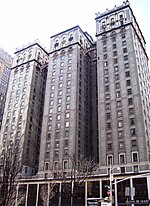James F. D. Lanier Residence
1903 establishments in New York CityBeaux-Arts architecture in New York CityHouses completed in 1903Houses in ManhattanHouses on the National Register of Historic Places in Manhattan ... and 4 more
Manhattan Registered Historic Place stubsManhattan building and structure stubsMurray Hill, ManhattanNew York City Designated Landmarks in Manhattan

The James F. D. Lanier Residence, also known as the James F. D. and Harriet Lanier House is an 11,638 sq ft (1,081.2 m2) historic house located at 123 East 35th Street between Park and Lexington Avenues in the Murray Hill neighborhood of Manhattan, New York City.
Excerpt from the Wikipedia article James F. D. Lanier Residence (License: CC BY-SA 3.0, Authors, Images).James F. D. Lanier Residence
East 35th Street, New York Manhattan
Geographical coordinates (GPS) Address Nearby Places Show on map
Geographical coordinates (GPS)
| Latitude | Longitude |
|---|---|
| N 40.7475 ° | E -73.980277777778 ° |
Address
East 35th Street 106
10016 New York, Manhattan
New York, United States
Open on Google Maps








